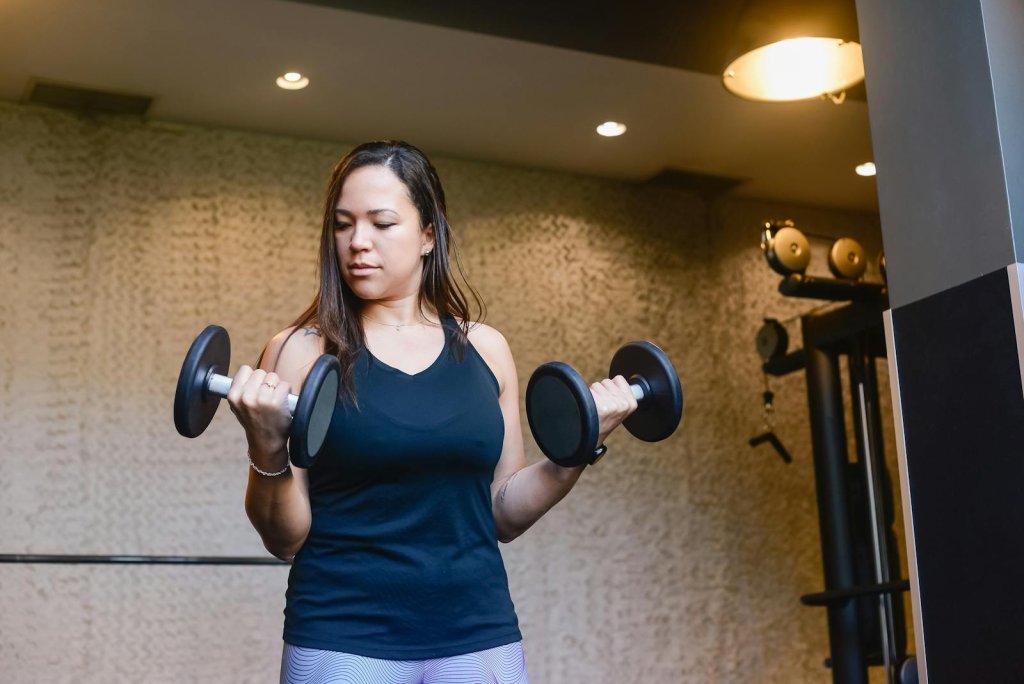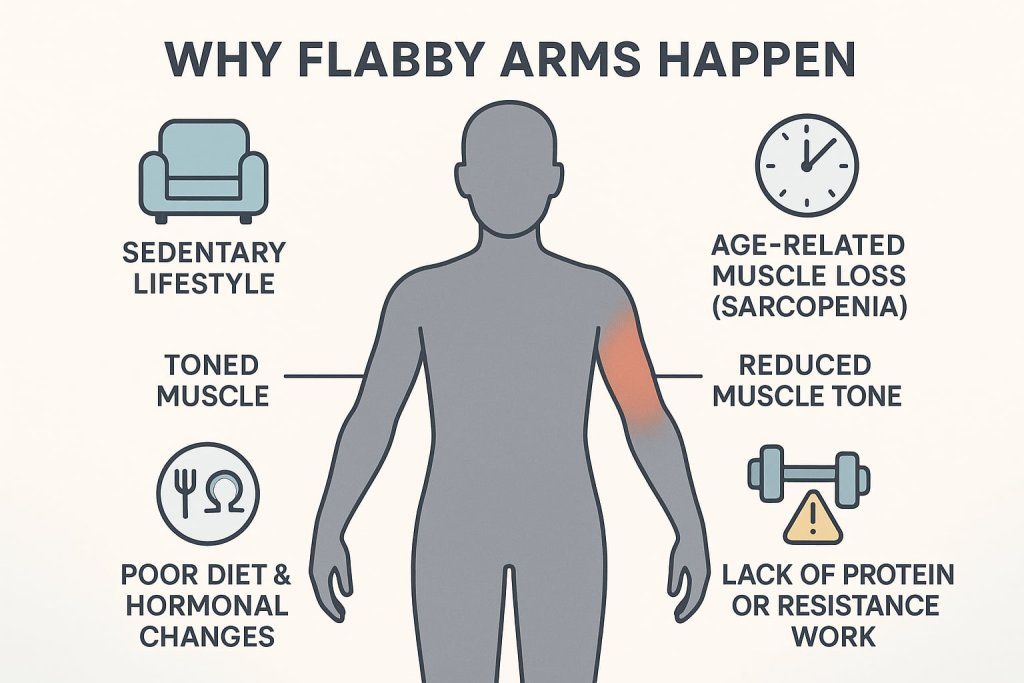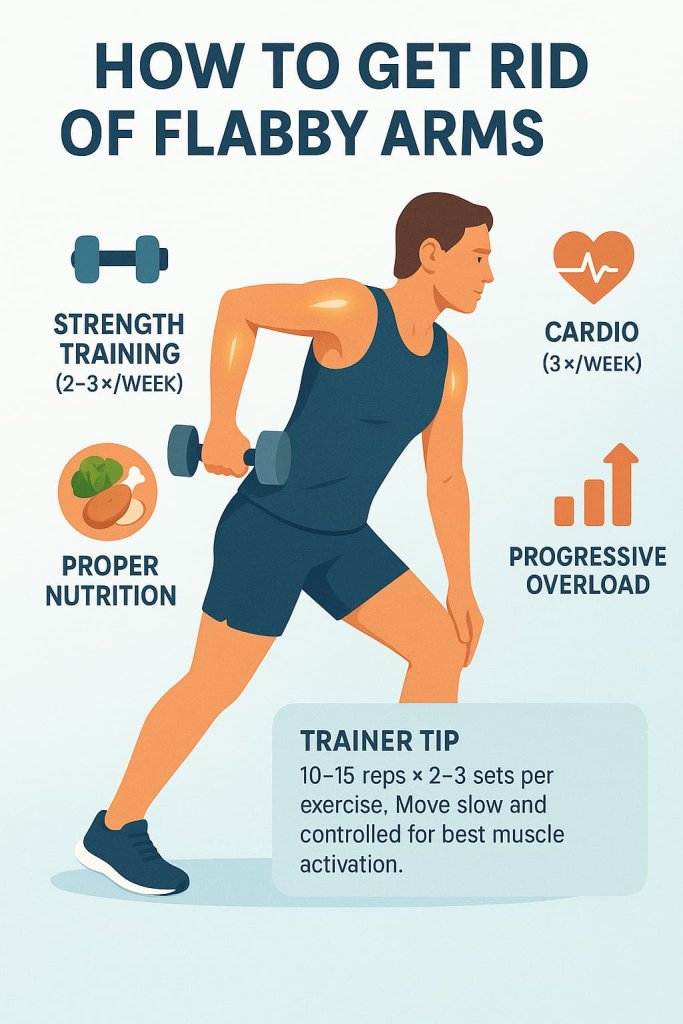The best way to get rid of flabby arms is through consistent strength training and overall fat loss.
You can’t spot-reduce fat, but you can tone and sculpt your arms by building lean muscle and improving body composition.

Understanding how to firm flabby arms is important — it improves confidence, posture, and upper-body strength.
This guide covers 15 of the most effective exercises targeting your biceps, triceps, shoulders, and upper back — the key areas responsible for firm, sculpted arms.
Why Flabby Arms Happen
Flabby arms — often called “bat wings” — occur when muscle tone decreases and body fat increases, especially in the triceps area.

Common causes include:
- Sedentary lifestyle or lack of strength training
- Age-related muscle loss (sarcopenia)
- Poor diet and hormonal changes
- Lack of protein intake or resistance work
But the good news? With smart, consistent workouts, you can tone and strengthen your arms at any age.
How to Get Rid of Flabby Arms Fast

To tighten flabby arms, combine:
- Strength training (2–3× per week)
- Cardio (3× per week) for fat burn
- Proper nutrition (calorie deficit + protein-rich meals)
- Progressive overload (increase resistance over time)
Trainer Tip: Aim for 10–15 reps × 2–3 sets per exercise. Focus on slow, controlled movement to fully activate muscles.
15 Best Flabby Arm Workouts
Each move below targets a specific muscle group for balanced, toned arms.
1. Tricep Dips
Why it works:
Tricep dips are among the most effective toning moves for eliminating flabby arms. This exercise directly targets the triceps — the muscle at the back of your upper arm that often loses firmness with age or inactivity. It also engages your shoulders and core for added stability, promoting a leaner, more defined upper body.
Muscles worked:
Triceps brachii (long and lateral heads), anterior deltoids, core stabilizers.
How to do it:
- Sit on a sturdy chair or bench with your hands gripping the edge beside your hips.
- Slide your hips off the edge so your weight is supported by your arms.
- Bend your elbows to lower your body until your upper arms are parallel to the floor.
- Press through your palms to extend your elbows and return to the starting position.
Perform 10–15 slow, controlled reps for 2–3 sets.
Trainer Tip:
Keep your elbows pointing straight behind you (not flaring out). To increase difficulty, straighten your legs or elevate your feet on another bench.
2. Push-Ups
Why it works:
Push-ups are a powerhouse compound exercise that sculpts not just your arms but your entire upper body. They tone the triceps, chest, and shoulders simultaneously while engaging the core. This move burns calories, improves posture, and builds lean strength — essential for reducing arm fat.
Muscles worked:
Pectorals, triceps, anterior deltoids, rectus abdominis, obliques.
How to do it:
- Begin in a high plank position with your hands slightly wider than shoulder-width apart.
- Engage your core, keeping your body in a straight line from head to heels.
- Lower your chest until it’s about an inch above the floor.
- Push through your palms to return to the starting position.
Aim for 10–12 controlled reps.
Trainer Tip:
Can’t do full push-ups yet? Start with knee or wall push-ups and gradually progress to full plank push-ups for optimal results.
3. Dumbbell Bicep Curls
Why it works:
Bicep curls build the front of your upper arms, creating visible shape and tone. They help balance triceps development, ensuring proportional arm definition. Over time, bicep curls increase muscle volume and firmness — reducing the “soft” look associated with flabby arms.
Muscles worked:
Biceps brachii, brachialis, brachioradialis (forearms).
How to do it:
- Stand tall with a dumbbell in each hand, palms facing forward.
- Keep your elbows tucked close to your torso.
- Curl the weights toward your shoulders, squeezing your biceps at the top.
- Lower the weights slowly to maximize time under tension.
Complete 3 sets of 12–15 reps.
Trainer Tip:
Move slowly and with control — no swinging! The slower the motion, the more your muscles work.
4. Overhead Tricep Extensions
Why it works:
This move targets the long head of your triceps, the largest part of the muscle responsible for the toned “horseshoe” shape at the back of your arms. Overhead tricep extensions are especially effective at tightening loose or sagging skin by strengthening deeper muscle fibers.
Muscles worked:
Triceps (long head), shoulders, core stabilizers.
How to do it:
- Hold a dumbbell with both hands and lift it overhead.
- Keep your upper arms still and bend your elbows to lower the dumbbell behind your head.
- Extend your elbows to raise the dumbbell back to starting position.
Do 12–15 reps for 2–3 sets.
Trainer Tip:
Avoid arching your lower back by keeping your core tight. Keep elbows close to your ears to fully engage the triceps.
5. Lateral Arm Raises
Why it works:
Lateral raises tone the outer shoulders and create a slimmer, more defined upper body silhouette. This move helps balance your arm shape by strengthening the deltoids, giving the illusion of leaner arms and better posture.
Muscles worked:
Lateral deltoids, trapezius, supraspinatus.
How to do it:
- Hold dumbbells at your sides with palms facing inward.
- Raise your arms out to the sides until they reach shoulder height.
- Pause briefly, then lower back down with control.
Perform 3 sets of 10–12 reps.
Trainer Tip:
Keep a slight bend in the elbows and avoid lifting higher than your shoulders to protect your joints.
6. Reverse Fly
Why it works:
The reverse fly strengthens your rear shoulders and upper back — crucial for improving posture and tightening the back of your arms. It’s an excellent complement to pressing movements like push-ups.
Muscles worked:
Posterior deltoids, rhomboids, middle traps, triceps stabilizers.
How to do it:
- Hold a dumbbell in each hand, palms facing each other.
- Hinge forward at the hips with a flat back.
- Raise your arms out to the sides until they align with your shoulders.
- Lower slowly and repeat.
Trainer Tip:
Focus on squeezing your shoulder blades together at the top — this improves upper-back engagement and overall tone.
7. Tricep Kickbacks
Why it works:
Kickbacks isolate the triceps and help sculpt lean, firm arms by targeting the back of the upper arm with precision. They’re great for creating definition and muscle separation.
Muscles worked:
Triceps brachii (all three heads).
How to do it:
- Hold a dumbbell in each hand and hinge forward slightly.
- Keep your elbows close to your ribs.
- Extend your arms straight back until fully extended, then return to start.
Perform 12–15 reps for 3 sets.
Trainer Tip:
Keep your upper arms fixed in place; only your forearms should move. Squeeze at full extension for maximum contraction.
8. Arm Circles
Why it works:
This simple yet effective endurance exercise tones your shoulders, triceps, and biceps while improving joint mobility and muscle stability. It’s an ideal warm-up before heavier resistance training.
Muscles worked:
Deltoids, triceps, biceps, rotator cuff muscles.
How to do it:
- Stand with feet hip-width apart, arms extended at shoulder height.
- Make small forward circles for 30 seconds, then reverse direction for 30 seconds.
- Rest briefly and repeat 2–3 rounds.
Trainer Tip:
Keep arms straight and shoulders relaxed. For added burn, hold 1–2 lb dumbbells or water bottles.
9. Hammer Curls
Why it works:
Hammer curls emphasize both the biceps and the forearms, building functional strength while increasing arm thickness and stability. They’re essential for overall arm symmetry.
Muscles worked:
Biceps brachii, brachialis, brachioradialis.
How to do it:
- Hold dumbbells with palms facing each other.
- Curl the weights toward your shoulders, maintaining this neutral grip.
- Lower back down slowly, keeping elbows close to your body.
Trainer Tip:
Perform controlled movements and avoid dropping the weights too quickly — slow negatives are key to muscle growth.
10. Plank Shoulder Taps
Why it works:
This core and arm combo move engages your shoulders, triceps, and abs at once — tightening your upper arms while improving balance and coordination.
Muscles worked:
Deltoids, triceps, core stabilizers, chest.
How to do it:
- Begin in a high plank position with hands under shoulders.
- Lift one hand to tap the opposite shoulder without rotating your hips.
- Alternate sides for 30–45 seconds per set.
Trainer Tip:
Widen your feet slightly to reduce rocking. Keep hips square for maximum stability and engagement.
11. Front Raises
Why it works:
Front raises sculpt the front of the shoulders and upper arms, improving posture and adding visual definition to your upper body.
Muscles worked:
Anterior deltoids, upper pectorals.
How to do it:
- Stand tall with dumbbells resting against your thighs.
- Raise both arms in front of you to shoulder height.
- Pause, then lower with control.
Trainer Tip:
Lift under control — not momentum. Avoid arching your back and maintain tight core engagement.
12. Wall Push-Ups
Why it works:
An excellent starting point for beginners or those with wrist issues, wall push-ups tone the triceps and chest without overloading the joints.
Muscles worked:
Triceps, pectorals, deltoids.
How to do it:
- Stand facing a wall, arms extended, palms flat at shoulder height.
- Bend elbows to bring your chest toward the wall.
- Push back until arms are straight.
Trainer Tip:
Increase intensity by stepping your feet farther from the wall or performing on a countertop for added resistance.
13. Resistance Band Pull-Aparts
Why it works:
This simple resistance band move strengthens the back of your shoulders and arms, improves posture, and tones the area under the arms.
Muscles worked:
Rear deltoids, rhomboids, traps.
How to do it:
- Hold a resistance band with arms extended at chest level.
- Pull the band apart by extending your arms outward until fully stretched.
- Slowly return to start and repeat.
Trainer Tip:
Keep shoulders down and avoid shrugging. Focus on squeezing shoulder blades together for best results.
14. Diamond Push-Ups
Why it works:
One of the most challenging and effective moves for the triceps, diamond push-ups build deep tone and strength while engaging the chest and core.
Muscles worked:
Triceps brachii, pectorals, deltoids, abs.
How to do it:
- Start in a high plank with hands together forming a diamond shape.
- Lower your chest toward your hands, keeping elbows close to your sides.
- Press back up to starting position.
Trainer Tip:
If you’re new, perform on knees or elevate your hands to reduce strain. Keep your spine straight throughout.
15. Dumbbell Shoulder Press
Why it works:
This overhead press builds strength in your shoulders and triceps while improving upper-body stability. It helps tone and tighten your arms while developing a firm, sculpted upper frame.
Muscles worked:
Deltoids, triceps, upper chest.
How to do it:
- Sit or stand with a dumbbell in each hand at shoulder height.
- Press the weights overhead until arms are fully extended.
- Lower them slowly back to the starting position.
Trainer Tip:
Keep your abs engaged and avoid arching your back. Exhale as you press upward and inhale as you lower.
Sample Weekly Arm-Toning Routine
| Day | Focus | Duration | Notes |
|---|---|---|---|
| Monday | Strength (Biceps + Triceps) | 30–40 min | Add curls, dips, extensions |
| Wednesday | Cardio + Arms | 35 min | Combine brisk walking + push-ups |
| Friday | Full-Body Tone | 40 min | Mix arm and compound moves |
| Sunday | Recovery & Mobility | 20 min | Gentle stretches or yoga |
American Council on Exercise (2024) recommends at least 48 hours of rest between arm strength sessions for optimal recovery.
Safety Tips and Recovery Essentials
- Warm up for 5 minutes before lifting (arm circles, light stretches).
- Use proper form — never rush repetitions.
- Rest at least 1 day between strength sessions.
- Hydrate before and after workouts.
- If you feel sharp pain, stop and consult a professional.
- Prioritize sleep (7–8 hrs/night) for muscle repair.
Nutrition Tips for Toned Arms
Arm definition isn’t just about workouts — nutrition is half the battle.
A balanced diet rich in lean protein, healthy fats, and complex carbs supports muscle recovery and fat loss.
Key guidelines:
- Include omega-3 fats (salmon, walnuts) for joint health
- Protein: 1.2–1.6g per kg body weight
- Hydration: 2–3 liters daily
- Avoid crash diets — they lead to muscle loss, not tone
FAQs
1. Can I really tone flabby arms at home?
Yes! Dumbbells, resistance bands, or even bodyweight can deliver great results when used consistently.
2. How long does it take to see results?
Visible tone appears in 4–6 weeks with consistent training and proper nutrition.
3. What’s the best exercise for flabby arms?
Tricep dips and overhead tricep extensions are most effective for firming the back of the arms.
4. Do I need heavy weights?
No — moderate resistance with correct form and slow tempo is more effective than heavy, sloppy reps.
5. Can cardio help tighten arms?
Yes. Cardio helps reduce overall fat, revealing toned muscles underneath.
6. Is it normal for arms to feel sore after training?
Yes — mild soreness is a sign of muscle growth. Rest and stretch between sessions.
7. Are arm workouts safe for seniors?
Absolutely! Low-impact versions (like wall push-ups and band pull-aparts) work great for all ages.
Conclusion
Flabby arms aren’t forever — with these 15 best flabby arm workouts, you’ll build strength, tone muscle, and tighten loose areas in just a few weeks.
Stay consistent, eat clean, and challenge yourself — your confidence will grow as fast as your strength.
👉 Start today — your toned, sculpted arms are just a few workouts away!
References
- CDC — Physical Activity Guidelines for Adults (2023–2024)
- Mayo Clinic — Strength Training: Get Stronger, Leaner, Healthier (2024)
- ACE (American Council on Exercise) — Triceps EMG Study: Most Effective Exercises
